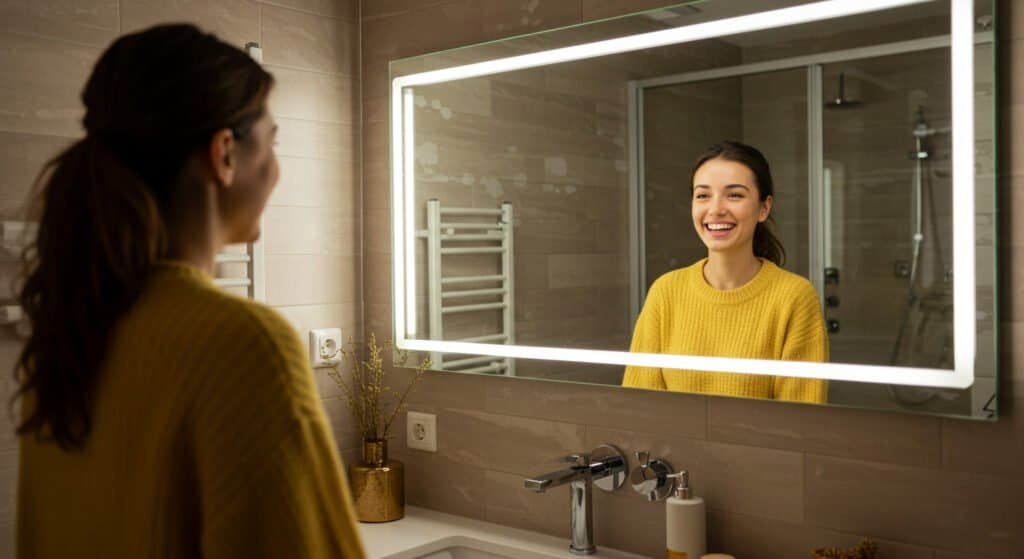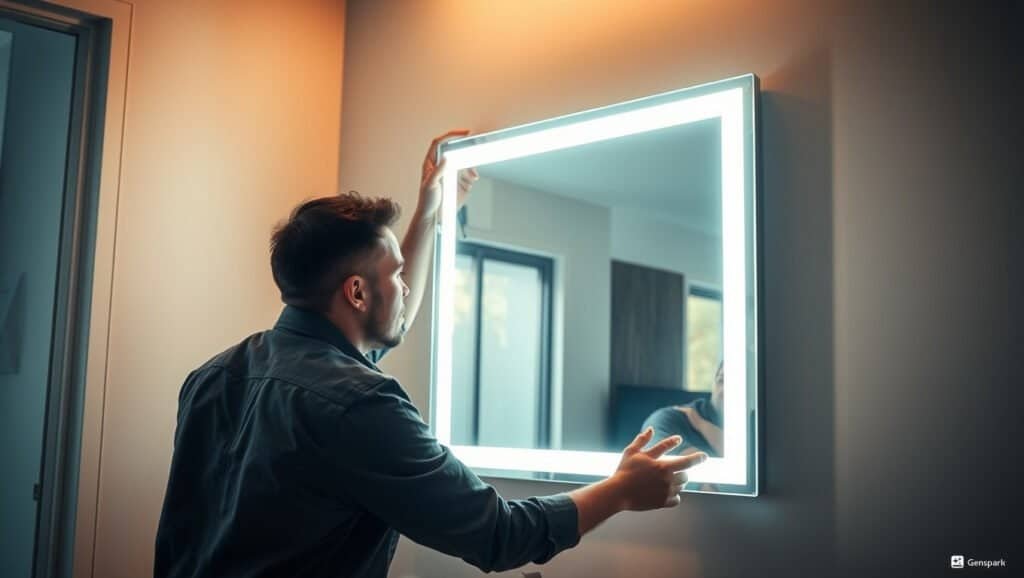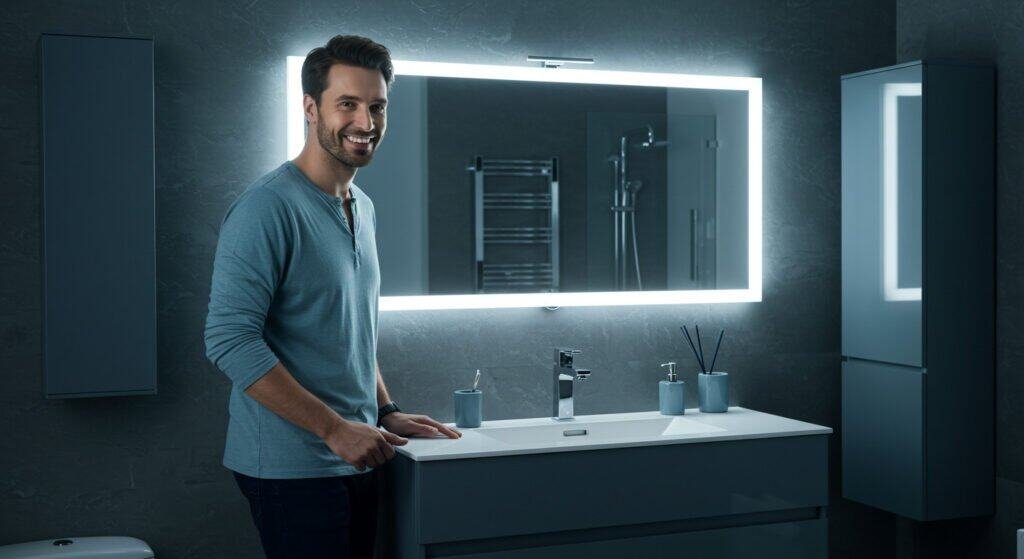Have you experienced sticker shock while shopping for a quality bathroom mirror? Why Are Mirrors So Expensive? Just like Rich Dad’s wisdom on assets versus liabilities, understanding why certain items command premium prices can save you from poor purchasing decisions.
Mirrors are expensive due to five key factors: quality of materials, manufacturing complexity, design specifications, integrated technology features like LED lighting, and brand positioning. Whether shopping for a basic glass mirror or high-end backlit mirror, these elements determine if you’re paying for genuine value or unnecessary markup.
Let’s uncover what actually drives mirror costs so you can make investment-grade decisions for your home.

Quality of Glass and Materials: The Foundation of Price
When examining mirror costs, the quality of glass serves as the primary price determinant, similar to how building foundations determine property value.
High-quality mirrors use premium glass with precise silvering that provides clearer reflections and greater durability. The difference between standard 3mm glass and premium 6mm mirror glass price points reflects this quality gap.
Superior materials create noticeable differences in performance and longevity. While cheap mirrors might use thinner glass with inconsistent coating, premium options feature even silvering, specialized backing materials to prevent corrosion, and higher-grade treatments that resist scratching.
Many luxury bathroom light mirrors incorporate safety features like tempered glass that prevent shattering—a crucial consideration that justifies higher pricing in high-moisture environments. Just as Rich Dad advocated investing in quality assets, spending more initially on better materials often becomes more economical over time.
Manufacturing Process and Technology: Complexity Creates Value
The manufacturing process significantly impacts mirror pricing, with advanced techniques commanding premium prices in today’s market.
Modern mirrors, especially LED light mirror vanity designs, require specialized manufacturing techniques including precision cutting, edge polishing, and advanced silvering methods. These processes demand skilled labor and sophisticated equipment.
The transformation from raw materials to finished product follows a fascinating journey of precision and expertise. Basic glass sheets undergo cutting, edge processing, cleaning, silvering, protective coating application, and quality inspection. For backlit mirrors, additional steps include incorporating LED systems, moisture protection, and electronic component integration.
Each specialized stage adds costs but creates a product with greater value, much like how a business’s complex systems create competitive advantages. Manufacturing excellence represents an investment in longevity—cheaper mirrors often reveal manufacturing shortcuts through uneven lighting, poor reflection quality, or rapid deterioration in bathroom environments.

Size and Design Complexity: Dimensions of Value
Size directly correlates with mirror pricing, as larger mirrors require more materials and present greater manufacturing challenges.
A wall mirror with lights costs more than standard options due to both size requirements and integration of lighting systems that must be precisely aligned.
Beyond basic measurements, design complexity creates significant price variations. Circular mirror gold frames command premium prices because they require specialized cutting techniques and precision framing. Custom shapes and beveled edges demand additional manufacturing steps and skilled craftsmanship.
Much like custom-built homes versus production models, premium mirrors reflect the cost of customization and design excellence. When evaluating price, consider whether unique design elements provide functional benefits or merely aesthetic ones—this thinking aligns with Rich Dad’s philosophy of distinguishing between value-adding assets and mere luxuries.
Integrated Smart Features: Technology Premium
Modern bathroom mirrors increasingly feature technological innovations that significantly impact price points.
Today’s premium bathroom mirror options include LED lighting systems, anti-fog technology, and smart features that transform them from simple reflective surfaces into functional home technology hubs.
The integration of electronics requires entirely different manufacturing approaches. Light up vanity mirrors incorporate complicated wiring systems, specialized diffusers for even lighting distribution, and often touch sensors or remote controls. High-end backlit mirrors might include Bluetooth connectivity, digital clocks, temperature displays, or motion sensors—each feature adding both value and cost.
When selecting mirrors with technology features, apply the Rich Dad principle of evaluating whether the functionality justifies the price premium. While basic vanity lighting serves essential purposes, advanced smart features might represent unnecessary expenses unless they solve specific problems in your daily routine.

Brand and Market Positioning: The Perception Factor
Brand reputation significantly influences mirror pricing beyond actual production costs or quality differences.
Designer brands position their mirrors as luxury items, while home improvement retailers like Home Depot mirrors represent more accessible pricing tiers with different quality expectations.
Premium brands invest heavily in design, quality control, and customer service—legitimate costs that contribute to higher prices. However, some pricing reflects positioning strategy more than actual value. Luxury brands command higher prices partly because their customers expect premium pricing as validation of exclusivity. This mirrors the financial world’s irrational valuations that Rich Dad cautioned against. Smart consumers recognize when they’re paying for genuine quality versus brand perception, developing the financial intelligence to differentiate between the two.
Why Are Mirrors So Expensive Now?
Recent years have seen notable price increases across mirror categories, particularly in specialized designs.
Post-pandemic supply chain disruptions have significantly impacted glass manufacturing, increasing costs for everything from basic bathroom mirrors to premium LED options.
Multiple factors drive today’s higher prices. Raw material costs have surged, particularly for high-quality glass and aluminum framing. Labor shortages in manufacturing sectors have increased production costs. Global shipping disruptions have particularly affected imported mirrors and components. Additionally, increased home renovation activity has created higher demand amid constrained supply. Just as Rich Dad taught about market cycles, understanding these temporary versus structural factors helps determine whether to purchase now or wait for more favorable pricing conditions.
Why Are Mirrors So Expensive in America?
American consumers often face higher mirror prices compared to other markets, particularly for specialty options like LED light mirror vanity systems.
The American market structure creates specific cost factors including transportation distances, retailer markup strategies, and consumer expectations for immediate availability.
Several market-specific factors drive higher U.S. pricing. Import tariffs significantly impact foreign-manufactured mirrors, particularly those with electrical components. Domestic manufacturing faces higher labor and regulatory compliance costs. Distribution networks spanning large geographic areas add substantial transportation expenses. Additionally, American consumers often demand extensive warranty coverage and post-purchase support—valuable services built into pricing. Understanding these regional factors helps evaluate whether imported options might provide better value despite potential warranty limitations.

How Much Do Mirrors Cost?
Mirror pricing spans remarkable ranges depending on type, quality, and features.
Basic glass mirrors might start around $50, while premium bathroom light mirrors with smart features can easily exceed $1,000 for larger installations.
Price varies dramatically across categories. Basic wall mirrors without frames typically range from $50-200 depending on size. Framed decorative mirrors span $100-500 based on frame materials and design complexity. Bathroom mirrors with integrated lighting systems generally start around $200, with premium backlit mirror options ranging from $400-1,500.
Custom or designer options can exceed $2,000. Smart mirrors with extensive technology integration represent the highest tier, often starting at $1,000. Like Rich Dad’s property investment approach, understanding different market segments helps identify where value opportunities exist within each category.
How Are Mirrors Made?
The manufacturing process directly impacts both quality and price across mirror categories.
Modern glass mirror production combines traditional techniques with advanced technology, creating significant differences between basic and premium options.
Mirror manufacturing follows several crucial steps. Base glass is cut to specification, then undergoes edge finishing to eliminate sharp edges. After thorough cleaning, silver or aluminum is deposited on the back surface through chemical processes. Protective backing is applied to prevent oxidation and damage.
For LED mirrors, additional manufacturing steps include circuit integration, diffuser installation, and waterproofing treatments. Quality control represents a major differentiator—premium manufacturers implement multiple inspection stages, while budget options might minimize this crucial step. Understanding this process helps explain why seemingly similar mirrors can have vastly different prices and longevity.
Is There a Difference Between Cheap and Expensive Mirrors?
Significant quality differences separate price tiers in the mirror market.
Expensive mirrors typically offer superior reflective quality, better color accuracy, and greater durability than cheap mirrors, particularly in high-humidity environments like bathrooms.
Quality differences manifest in several ways. Premium mirrors provide more accurate reflections without distortion or color shifting. Higher-end options resist environmental damage like moisture-related spotting or edge deterioration. Construction quality becomes apparent in details like frame sturdiness, mounting hardware reliability, and edge finishing precision.
Expensive mirrors often incorporate advanced features like adjustable lighting temperature in LED bathroom mirrors. As Rich Dad emphasized regarding real assets versus liabilities, quality mirrors maintain their functionality and appearance for decades, while cheaper alternatives often require replacement within a few years, ultimately costing more over time.

How Can You Tell if a Mirror is Good Quality?
Identifying quality mirrors requires examining specific indicators beyond mere appearance.
Professional evaluations focus on reflection clarity, edge finishing precision, frame construction, and for bathroom light mirrors, lighting consistency and hardware quality.
Several tests reveal mirror quality. Check reflection clarity by viewing text through the mirror at an angle—quality mirrors maintain legibility without distortion. Examine edges for smooth, consistent finishing without chips or rough areas. For framed options, verify corner joints are tight and properly aligned. With light up vanity mirrors, test for even illumination without hot spots or flickering.
Evaluate mounting hardware for sturdiness and corrosion resistance. Finally, consider warranty coverage—premium manufacturers typically offer longer protection reflecting their confidence in durability. This evaluation approach reflects Rich Dad’s principle of thoroughly examining investments before committing resources.
Are Mirrors Worth Money?
Quality mirrors represent genuine value from both practical and investment perspectives.
Well-made mirrors, particularly versatile options like wall mirrors with lights, deliver functionality that justifies their cost through years of reliable service.
Several factors determine long-term value. Premium mirrors maintain appearance and performance for decades rather than years. Higher-quality options resist environmental damage, particularly important for bathroom installations. Advanced LED mirrors provide better lighting quality for daily tasks.
Additionally, quality mirrors often enhance property value, particularly in bathroom renovations. The Rich Dad perspective would evaluate mirrors not merely on purchase price but on long-term cost-effectiveness—quality models requiring one purchase versus repeated replacements of inferior products that ultimately cost more while delivering less satisfaction.
Do We Look Better or Worse in Mirrors?
Mirror quality significantly impacts how accurately we see ourselves.
Premium mirrors provide more truthful reflections than budget options, which can distort appearance through subtle warping or color tinting.
Several factors influence reflection accuracy. Quality glass provides flatter surfaces with fewer imperfections that might distort images. Superior silvering creates more precise reflections without color shifting. Lighting quality dramatically affects appearance—premium bathroom light mirrors provide even illumination that minimizes unflattering shadows.
Premium backlit mirrors often offer adjustable lighting temperature settings that more accurately represent how you’ll appear in different environments. Understanding these factors helps evaluate whether a mirror shows your true appearance or a distorted version—much like Rich Dad’s emphasis on seeing financial reality clearly rather than through distorted perspectives.

Were Mirrors Expensive in the Past?
Historically, mirrors represented extreme luxury items accessible only to the wealthy.
Ancient mirrors made from polished metal were rare possessions, while early glass mirrors required extraordinary craftsmanship that made them equivalents to fine art.
Mirror pricing has evolved dramatically. Before modern manufacturing, creating reflective surfaces required laborious hand-polishing of metal or applying precious metals to glass. Venetian mirror makers in the 17th century commanded prices equivalent to the cost of naval ships for their finest works.
Mass production in the 19th century began democratizing access, though quality mirrors remained significant investments. Today’s manufacturing efficiencies have made basic mirrors widely accessible, though premium options like circular mirror gold designs still command luxury pricing. This historical perspective provides context for evaluating today’s pricing relative to the remarkable craftsmanship and technology incorporated into modern mirrors.
Is it Good to Have a Lot of Mirrors in Your House?
Strategic mirror placement creates both practical and aesthetic benefits. Quality wall mirrors with lights expand visual space while improving functionality, particularly in smaller rooms or darker areas.
Several considerations should guide mirror quantity and placement. Mirrors effectively expand perceived space when positioned to reflect windows or open areas. They increase natural light utilization by reflecting and amplifying available illumination. However, excessive mirroring can create disorienting effects or clash with overall design cohesion.
From a practical perspective, having appropriate mirrors in entrance areas, bathrooms, and dressing areas serves daily needs, while decorative pieces enhance specific design elements. Like Rich Dad’s emphasis on purposeful acquisition rather than accumulation, mirror placement should follow intentional planning rather than random collection.
What is Trending in Mirrors?
Current mirror trends emphasize both technological integration and distinctive design elements.
LED mirror technology continues advancing with more energy-efficient lighting, customizable options, and integration with smart home systems.
Several design directions dominate today’s market. Frameless bathroom light mirrors with integrated LED systems remain strong sellers for their clean aesthetic and functional lighting. Mixed material frames combining wood, metal or other elements create distinctive design statements. Backlit mirrors providing ambient lighting continue gaining popularity for both practical and aesthetic benefits.
Irregular and organic shapes represent growing alternatives to traditional rectangular formats. Smart mirrors integrating voice control, touch screens, or other interactive elements represent the premium segment’s future direction. Understanding these trends helps evaluate whether specific features represent lasting value or temporary fashion—an important distinction in any investment decision.

Are Mirrors Cheaper to Make Than Lenses?
Mirror manufacturing differs fundamentally from lens production in both complexity and precision requirements.
While basic glass mirrors cost less than precision optical lenses, advanced options like modern LED light mirror vanity systems involve completely different manufacturing approaches that prevent direct comparison.
Several factors distinguish these manufacturing processes. Mirrors require precise surface flatness but not the complicated curvature calculations of optical lenses. Mirror silvering demands careful chemical processes but less precision than lens grinding and polishing.
However, modern bathroom mirror technology with integrated electronics introduces complexity absent from basic lens manufacturing. Neither product category is inherently “cheaper” to produce—they simply involve different manufacturing challenges and material requirements. This comparison illustrates Rich Dad’s principle that true value comes from understanding the underlying production realities rather than surface-level pricing.
Conclusion
Understanding why mirrors command different price points empowers smarter purchasing decisions, whether selecting a basic glass mirror or premium bathroom light mirror.
Quality materials, manufacturing excellence, design complexity, technological integration, and brand positioning all contribute to pricing variations, creating genuine value differences across categories.
Just as Rich Dad taught evaluating investments based on true value rather than initial cost, approach mirror selection by analyzing long-term benefits against purchase price. The most expensive option isn’t always necessary, but understanding quality indicators helps avoid false economy that leads to repeated replacements and greater long-term expense.


